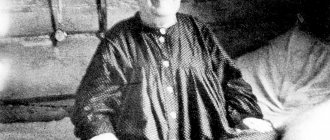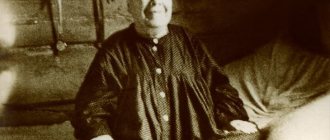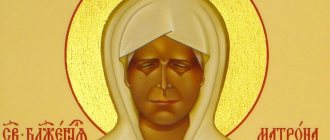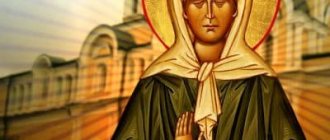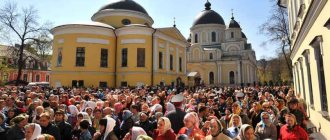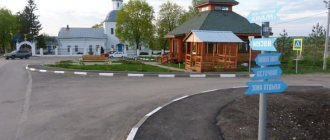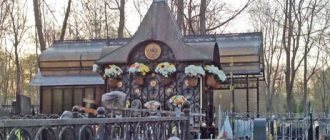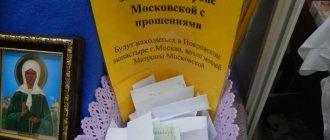Reverend Mother Matrona of Moscow is the most revered old woman in the Russian Orthodox Church. Today, the prayer to Matrona of Moscow for help carries that positive and healing energy of God, which makes the soul feel lighter. Being blind and immobilized, homeless and illiterate, she wandered around Moscow houses. However, the most important thing that distinguished her from other people was that she had deep faith in Christ, which was given to help not only the saint herself, but also all the people whom she always willingly helped.
About Blessed Mother Matrona
Matrona Dmitrievna Nikonova had the gift of healing, and could also open the secret curtain of the future and make predictions. She spent more than 50 years in a sitting position and was blind, but she saw through the inner world of people and always prayed for all those in need with her unceasing prayer.
Today, believers from all over Russia, those who know where the relics of Matrona of Moscow are, go to her to honor her memory and ask for protection and help. After all, many know the words of the holy old woman: “Everyone, everyone, come to me and tell me, as if alive, about your sorrows, I will see, listen and help you.”
Before answering the question of how to venerate the relics of the Matrona of Moscow, you must first familiarize yourself with the history of her life and holiness.
Miracles of Matrona of Moscow for women in labor: how to pray, what to ask for
Blessed Matrona of Moscow (in the world - Matrona Dmitrievna Nikonova) - was born in 1881 in one of the villages of the Tula province. The peasant family lived poorly, and the parents were ready to give their unborn daughter to an orphanage, but shortly before giving birth, the mother had a prophetic dream: her daughter in the form of a bird with her eyes closed. The girl was born blind, and her parents decided to leave her. Already as a child, she began to heal the sick who came to her house. At the age of 18, Matrona lost her legs, but she continued to pray for the sick who asked for help - and achieved results.
In 1925 she moved to Moscow. It is known that Matrona Dmitrievna lived in the vicinity of Pyatnitskaya Street in Zamoskvorechye - in the parish of the Church of the Life-Giving Trinity in Veshnyaki. As Father Philip Ilyashenko, who serves in this church today, told MK, Matrona’s example is very useful for us today - to reconsider what we call “deprivation” and change our attitude towards them.
– You need to think about how much the inner essence of a person does not depend on external factors. Limitations - the inability to see, move freely, communicate with the outside world - may mean nothing. From birth, Matrona was deprived of our natural communication capabilities. She was born blind and quickly lost the ability to walk. She had neither physical strength nor social status, but she had the greatest influence on her contemporaries, and now on us, their descendants.
Father Philip clarified: You can pray to Matronushka for anything and from anywhere - the peculiarity of this saint is that she will hear everyone. However, most often, as the parishioners themselves testify, she is asked about simple everyday things: love, the birth of children and well-being in the family.
– In fact, it’s almost a paradox. Matrona has never had prosperity - in the sense in which we understand it today - but we ask her for simple, topical things. Perhaps Matrona’s example is perfect for us today to learn humility,” added Father Philip. “We’ve been sitting in self-isolation for a month and grumbling: we’re scared, annoyed, but we’re afraid that if we get sick, they won’t be able to save us all at the same time.” But we don't want to sit in quarantine. And she sat like this all her life, she had no choice - and not even in our prosperous, well-fed time, but in the first half of the twentieth century: she experienced war, religious persecution, repression and famine.
The priest suggested remembering the experience of our ancestors: after all, in the 1950-60s it was impossible to come to church, but you could pray anywhere: at home, if you had faith.
“Now it’s time for us to remember this - not try to come to the temple, but just think about her and say, “Matrona, help.” Matrona has endured her whole life, but we only have a couple of weeks left to endure,” the priest summed up.
So you can ask the saint for anything: for the health of your family and friends, as well as for relief from worries and fears - during the epidemic that has hit the whole world today, this seems especially relevant.
Matrona died on May 2, 1952. It is believed that she knew the hour of her death in advance. Shortly before her death, she said: “Everyone, everyone, come to me and tell me, as if alive, about your sorrows, I will see you, and hear you, and help you.”
She was buried at the Danilovsky cemetery. Matrona was glorified among the locally revered saints of the Moscow diocese in 1999, and canonized as a universally revered saint in the church in 2004. Now the shrine with the relics of the blessed Matrona of Moscow is kept in the Intercession Convent in Moscow. People asking how to get to Matronushka can be found in the vicinity of the Taganskaya metro station (where the monastery is located) almost around the clock. Most often these are women - it is generally accepted that they pray to Matrona of Moscow for happiness in marriage, for the birth of children and to find true love. You can also ask for help near Matrona’s grave at the Danilovsky cemetery - but, of course, after the end of self-isolation.
HELP "MK"
There are several known exact cases when prayers to Matrona led to healing.
Even before the war, a woman from a neighboring village approached her and said that her husband had stopped walking. Matrona told her to let her husband crawl to her on his own - the journey should have taken 3 hours. And so it happened. He walked back on his own feet.
Another woman came to pray for her brother, whose legs and arms had failed and he could barely move his tongue. Matrona said: “Bring it.” When they brought him, she said prayers, gave him water, and he fell into a deep sleep. When I woke up, I was able to walk and talk and was completely healed.
There are cases when Matrona of Moscow predicted the future. So, for example, during the war, she told the woman with whom she lived that her husband would return home and knock on the window - despite the fact that the man had a funeral. However, this is what happened in 1947. Another story is when Matrona told the policeman who was going to arrest her that he had a great misfortune at home. It turned out that there was a gas explosion; the policeman’s wife was seriously injured, but survived thanks to timely help.
According to one legend, in 1941 Joseph Stalin came to Matrona and asked her about the outcome of the outbreak of the World War. Matrona said: “You will win.” However, historians debate whether this event actually happened.
BY THE WAY
Here is the prayer that should be read to Saint Matrona of Moscow:
“Oh, blessed Mother Matrona, standing with her soul in Heaven before the Throne of God, resting with her body on earth and exuding various miracles with the grace given to you from above! Look now with your merciful eye on us sinners, spending our days in sorrows, illnesses and sinful temptations. Comfort us, the despairing, heal our grave ailments, which God allows us because of our sins, deliver us from many troubles and misfortunes, beg our Lord Jesus Christ to forgive us all our sins, iniquities and falls, which we have suffered from our youth even to the present day and hour we have sinned, so that through your prayers, having received grace and great mercy, we glorify in the Trinity the One God, the Father and the Son and the Holy Spirit, now and always and unto the ages of ages. Amen".
Biography
In November 1881, a girl was born into an ordinary Nikonov family in the village of Sebino, in the Tula province, who was named Matrona. She became the fourth child in the family, as she already had two brothers and a sister. Poor Matronushka was born blind, and they already wanted to leave her in an orphanage. However, the mother had a prophetic dream: she saw a beautiful white bird that sat on her chest, which had no eyes. The parents guessed that Matrona would become God's chosen child by the beneficial cloud of smoke at the moment of her birth. Already at the age of eight, she had a strong faith in God, and soon the gift of a wise seer was revealed. Crowds of people began to come to her for help and healing. Matronushka became a real breadwinner in her family. And at the age of 18 her legs became paralyzed.
What you can and cannot ask from Saint Matrona of Moscow
Orthodox Christians turn to Saint Matrona of Moscow They pray to her to heal themselves or loved ones from serious illnesses. Infertile women who dream of having a child come to her for help. They also pray to the saint for a meeting with her betrothed, for the strength to achieve their goals, for the innocently convicted, for people with mental disorders, for the right choice at a crossroads in life.
You cannot ask a saint for material wealth. Money is a goal for which a person does not need God’s help. The saint is asked for a new job only in the most difficult life situations. In general, changes of this nature depend on the person himself.
You cannot turn to a saint if your heart is full of malice, envy, and hatred of other people. All requests must be pure and unselfish. You cannot ask for harm that may be caused to other people, since trouble may later fall on the head of the person asking.
It is important not to forget that any manifestation of vice will be seen by Higher powers. It is useless to ask for harmony in the family to a person who himself does nothing to improve the situation. It is better not to ask for personal happiness, which may bring misfortune to another person. That is, a prayer for reunification with a loved one who is someone else’s husband is unlikely to be heard.
Pilgrimage
Having the gift of God, Matrona saved many people and was very kind to them. She had a bright face and a very gentle voice. She would pat everyone on the head, console them, and apply her sign of the cross, and this made people’s souls feel lighter, they were comforted and calmed down. Although she herself was very sick, no one heard any complaints from her.
Being very young, Matrona, together with the daughter of a local landowner, Lydia Yankova, made a pilgrimage to holy places. They visited the Kiev Pechersk and St. Petersburg Trinity-Sergius Lavras, as well as other holy places in Russia.
Matrona also visited the Kronstadt Cathedral in 1899. There, the Monk John of Kronstadt, at the end of the service, asked all the parishioners to make way and let Matrona through and said: “Matronushka, come, come to me. Here comes my shift—the eighth pillar of Russia.”
War
From 1942 to 1949, the Reverend Matrona lived with her fellow villagers - E. M. Zhdanova and her daughter Zinaida. For many years there has been a legend that was described in the book of memoirs of Zinaida Zhdanova “The Tale of Matrona”. During the Great Patriotic War, a serious threat arose that the capital would be captured by the German fascists; Stalin himself came to Matrona. She predicted the victory of the Russian people and said that he alone of all the authorities would not leave and would remain in Moscow. Unfortunately, there is no evidence of this event, but I think it happened.
From 1950 to 1952, she already lived in Skhodnya near Moscow with her distant relatives, the Kurochkins.
The holy elder Matrona predicted her death three days in advance. Being very sick, she still continued to see people. The holy mother died in the spring of May 2, 1952.
Relics of Matrona of Moscow. Monastery
The funeral service was conducted by Archpriest Nikolai Golubtsov, who revered Mother Matrona, in the Church of the Deposition of the Robe. On May 4, the Sunday of the Holy Myrrh-Bearing Women, the burial of the holy old woman took place, at which a large number of believers gathered. She was buried at the Danilovsky cemetery at the request of her mother herself. This church was one of the few that operated in Moscow, so she always wanted to “hear the service.”
On March 8, 1998, with the blessing of Patriarch Alexy II, the incorrupt relics of Holy Mother Matrona were removed from the grave and were first taken to the Danilov Monastery, and then to the Pokrovsky Monastery.
Now pilgrims are always allowed to visit the relics of Matrona of Moscow from 6.00 to 20.00. They are placed in a silver shrine and are located in the Intercession Convent in Moscow. There is also a public exhibition with surviving photographs. And in the courtyard of the Trinity Church, not far from the Skhodnya station, a chapel was built in honor of the elder Mother Matrona.
But it’s not only there that you can venerate the saint. A particle of the relics of the Matrona of Moscow is in many Moscow churches. The remains are also transported to other cities.
How to properly contact Matrona
According to believers, Matrona helps those suffering in a variety of cases, and during her lifetime she did not push anyone away. People affectionately call Matrona “barefoot.” How to ask for help: prayer, like any other Saint of the Orthodox Church. There are icons with the face of Matrona in many churches; you can put an icon at home and pray to it. If life circumstances allow you to come to the Intercession Monastery in Moscow, stand there with other pilgrims and venerate the icon and relics of the Saint - this is a good deed. But we must remember that Saints hear prayers said anywhere, the main thing is that they come from the heart.
There are the following ways to ask Matrona for help:
- Come to the church of your hometown, where there is an icon with the face of the Holy One.
- Visit the Intercession Monastery in Moscow.
- Come to the grave of the Blessed One at the Danilovsky cemetery in Moscow. In 1998, her relics were transferred to the Intercession Monastery, but believers still come to the grave and, expressing veneration for the Saint, light candles and read prayers.
- Place an icon of the Matrona of Moscow at home and pray to her for help every day.
- Now it is possible to purchase silver coins with the face of the Saint.
How to venerate the relics of Matrona of Moscow?
Mother Matrona helps in all everyday matters. She is asked for intercession, healing and solutions to problems in personal life and business. Prayer to Matrona of Moscow for help helps to arrange your personal life, give birth to a child, or detect a loss. The humble prayer to the holy mother must be said sincerely and with attention. It begins with the words: “Oh, blessed mother Matrono...” The short prayer sounds like this: “Holy righteous old woman Matrono, pray to God for us!”
Before venerating the relics of Matrona of Moscow, we must first of all understand that this is how we show our reverence and respect to her incorruptible body, which testifies to her great spirituality and holiness. Reverence for shrines is an integral part of the culture of the Russian Orthodox people.
Application to the holy relics
Before venerating the relics of the Matrona of Moscow, you need to free yourself from bags and outerwear. In this way we show deep respect to the holy righteous Matronushka. So that after visiting the temple at least some shrine remains, you can ask the church minister to attach a small image or icon to the relics. True believers kiss the reliquary, expressing respect and love for the holy mother, then put their foreheads to it, which symbolizes an embrace.
How to venerate the relics of Matrona of Moscow? It is necessary to mentally say a prayer calmly and with concentration, then cross yourself twice. Next, you need to make two bows and put your lips to the shrine with the relics of the saint. Then cross yourself and bow again. Bows are best done from the waist so that the hand touches the ground.
Folk customs when reading a prayer
Believers say that if you accompany the prayer to Matronushka with certain actions, they have great power. For example, before going to church to see the icon or relics of the Matrona of Moscow, it is better to leave a donation to the temple in the form of food, remembering that this is exactly the kind of gratitude the Saint received during her lifetime. They usually bring bread and other baked goods, tea, sugar, flour, nuts, and honey. You need to do this at least once a week for a month before the pilgrimage.
It is good to do a good deed: help the poor, donate money to the sick, etc. And you must go to Matrona with pure thoughts and firm faith in the fulfillment of what you want.
It is customary to bring Saint flowers alive. She loved white lilacs, chrysanthemums, red carnations, tulips, and any roses. According to the legends about Matronushka’s life, she was very fond of rowan berries brought from the frost. It is a good omen to plant a chokeberry tree in honor of the Saint. So Matrona will become the intercessor of the entire home and family.
Flowers for Mother Matrona
In the temple there is a special custom of bringing living bouquets to Blessed Mother Matrona. Therefore, the chapel, where the shrine with holy relics is located, is always buried in fresh flowers. And what is most interesting is that the offering of some becomes a real gift for others, since the nuns present each visitor to the relics of St. Matronushka with a flower. These flowers are consecrated directly on the relics, and therefore they are then usually dried and stored in their corner near the icons. Flowers you can bring are carnations, roses of any color, white chrysanthemums, white lilacs, red tulips.
Why do Orthodox Christians venerate the relics of God's saints?
The tradition of venerating the relics of holy saints is based on the miracle of the Incarnation. The Christian Church believes that Jesus Christ was resurrected not only spiritually, but also physically, therefore the physical shell of a person has no less value than the soul. People who achieved unity with the Lord during their lifetime became the receptacle of His Grace, which they poured out into the world around them. This ability is possessed not only by a living body, but also by the remains of a holy person.
Holy relics are the greatest shrines of the Orthodox Church
The veneration of holy relics was officially established at the Second Ecumenical Council. At the same time, the priests emphasized the importance of understanding the fact that worship is performed neither to the remains nor to the person, but to the Divine Power contained in them.


